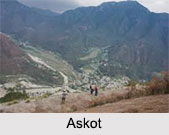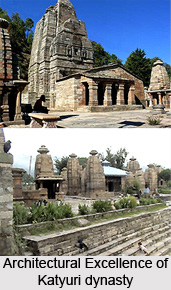 Askot is a small Himalayan town in the Didihat tehsil of the Pithoragarh district in the state of Uttarakhand, which forms a part of the Indian subcontinent. The name of this beautiful town is derived from `Assi Kot` or Eighty Forts, many of which are situated in Nepal. The best time to visit Askot is the period between April to September.
Askot is a small Himalayan town in the Didihat tehsil of the Pithoragarh district in the state of Uttarakhand, which forms a part of the Indian subcontinent. The name of this beautiful town is derived from `Assi Kot` or Eighty Forts, many of which are situated in Nepal. The best time to visit Askot is the period between April to September.
History of Askot
The history of the town of Askot can be traced back to the times when Askot was under the reign of the Doti monarchs of Nepal. In the following decades Askot became the ancient capital of the Katyuri monarchy. After the decline of the Katyuri dynasty, it was Emperor Abhay Pal who came to this place and established the state of Askot by taking it as a grant from the Doti kings in 1279 A.D. Askot remained under the Doti kings for some time. After that they came under the rule of Chand rulers. The successors of Abhay Pal ruled Askot from 1279 to 1588. At that point of time Askot was divided under two regions namely Malla Askot and Talla Askot. The area came under the control of the Gorkhas in 1742 but the descendants continued to revolt against each other. Even after the British defeated the Gorkhas in 1815, the family conflict continued to exist. Before the town of Askot became the capital, the king used to live near riverbank of Bagarihat.
Location of Askot
 Askot is located on a bridge, which lies midway between the Pithoragarh and Dharchula Road. The religious tour of Kailash Mansarovar passes through this place. The town of Askot is located on the River Gori Ganga-Kali under the geographical divisions. The town is situated amongst a beautiful natural setting of trees like Quercus, Pinus, and Rhododendron. The fertile slopes of Garkha are located on the front side of this town and the River Kali and mountains of Nepal on the left side of the town. An endangered tribe called Van Rawats inhabits this region. The area of Askot is also under heavy underground tunnel mining operations and there are a number of deposits in this area including that of copper, zinc, silver, gold and lead deposits.
Askot is located on a bridge, which lies midway between the Pithoragarh and Dharchula Road. The religious tour of Kailash Mansarovar passes through this place. The town of Askot is located on the River Gori Ganga-Kali under the geographical divisions. The town is situated amongst a beautiful natural setting of trees like Quercus, Pinus, and Rhododendron. The fertile slopes of Garkha are located on the front side of this town and the River Kali and mountains of Nepal on the left side of the town. An endangered tribe called Van Rawats inhabits this region. The area of Askot is also under heavy underground tunnel mining operations and there are a number of deposits in this area including that of copper, zinc, silver, gold and lead deposits.
Tourism of Askot
The town of Askot has a host of tourist spots, which attracts thousands of tourists to this region every year. The place is most famous for the Askot Wild Life Sanctuary for the conservation of musk deer. The Askot Sanctuary situated in the Pithoragarh district is surrounded by mountains and forests and is the best dwelling place for wild beasts. This popular is the house of wild animals like leopards, bears, deer, kakars and a great variety of birds. Lying at the lap of the Himalayan range at a height of 5412 ft. this sanctuary is visited by thousands of tourists from both India and abroad every year. Reaching the town of Askot is very convenient nowadays. The nearest airport to the town of Askot is Jolly Grant, Dehradun. The nearest railhead is Tanakpur, which is at a distance of 151 kilometers from Askot. The town of Askot is also accessible by road via Tanakpur. Accommodation is not a problem in the town of Askot. Forest rest houses are available at Askot and also in the adjoining areas of Kaflani, Tejam and Rugling.



















